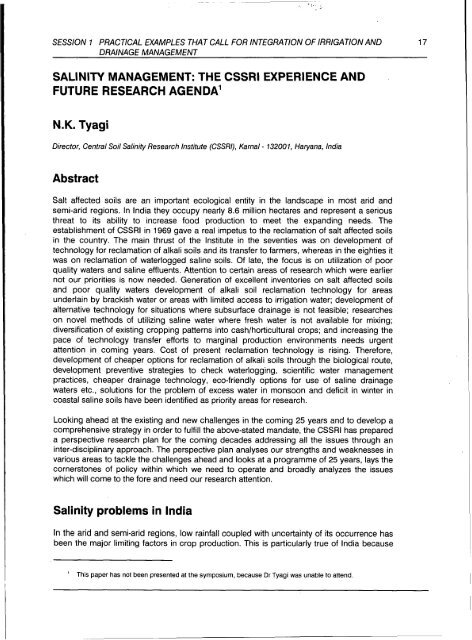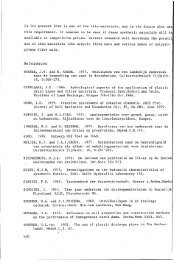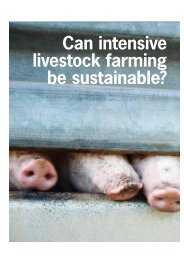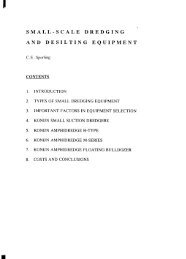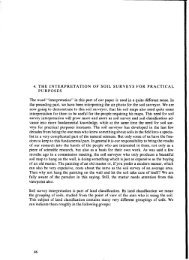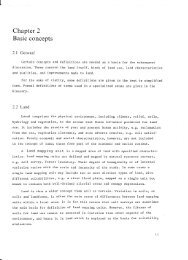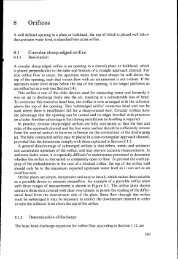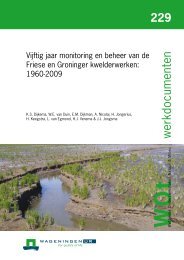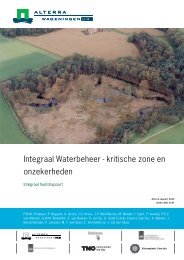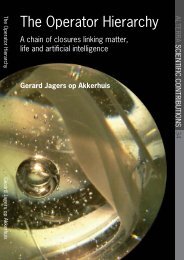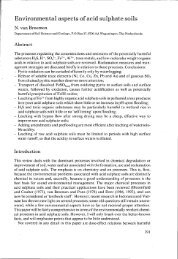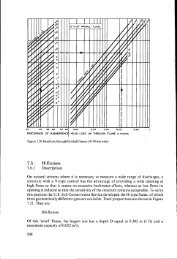FUTURE RESEARCH AGENDA' Abstract Salinity problems in India
FUTURE RESEARCH AGENDA' Abstract Salinity problems in India
FUTURE RESEARCH AGENDA' Abstract Salinity problems in India
- No tags were found...
You also want an ePaper? Increase the reach of your titles
YUMPU automatically turns print PDFs into web optimized ePapers that Google loves.
SESSION 1 PRACTICAL EXAMPLES THAT CALL FOR INTEGRATION OF IRRIGATION AND 17DRAINAGE MANAGEMENTSALINITY MANAGEMENT: THE CSSRI EXPERIENCE AND<strong>FUTURE</strong> <strong>RESEARCH</strong> <strong>AGENDA'</strong>N.K. TyagiDirector, Central Soil <strong>Sal<strong>in</strong>ity</strong> Research Institute (CSSRI), Karnal - 132001, Havana, <strong>India</strong><strong>Abstract</strong>Salt affected soils are an important ecological entity <strong>in</strong> the landscape <strong>in</strong> most arid andsemi-arid regions. In <strong>India</strong> they occupy nearly 8.6 million hectares and represent a seriousthreat to its ability to <strong>in</strong>crease food production to meet the expand<strong>in</strong>g needs. Theestablishment of CSSRl <strong>in</strong> 1969 gave a real impetus to the reclamation of salt affected soils<strong>in</strong> the country. The ma<strong>in</strong> thrust of the Institute <strong>in</strong> the seventies was on development oftechnology for reclamation of alkali soils and its transfer to farmers, whereas <strong>in</strong> the eighties itwas on reclamation of waterlogged sal<strong>in</strong>e soils. Of late, the focus is on utilization of poorquality waters and sal<strong>in</strong>e effluents. Attention to certa<strong>in</strong> areas of research which were earliernot our priorities is now needed. Generation of excellent <strong>in</strong>ventories on salt affected soilsand poor quality waters development of alkali soil reclamation technology for areasunderla<strong>in</strong> by brackish water or areas with limited access to irrigation water; development ofalternative technology for situations where subsurface dra<strong>in</strong>age is not feasible; researcheson novel methods of utiliz<strong>in</strong>g sal<strong>in</strong>e water where fresh water is not available for mix<strong>in</strong>g;diversification of exist<strong>in</strong>g cropp<strong>in</strong>g patterns <strong>in</strong>to cash/horticultural crops; and <strong>in</strong>creas<strong>in</strong>g thepace of technology transfer efforts to marg<strong>in</strong>al production environments needs urgentattention <strong>in</strong> com<strong>in</strong>g years. Cost of present reclamation technology is ris<strong>in</strong>g. Therefore,development of cheaper options for reclamation of alkali soils through the biological route,development preventive strategies to check waterlogg<strong>in</strong>g, scientific water managementpractices, cheaper dra<strong>in</strong>age technology, eco-friendly options for use of sal<strong>in</strong>e dra<strong>in</strong>agewaters etc., solutions for the problem of excess water <strong>in</strong> monsoon and deficit <strong>in</strong> w<strong>in</strong>ter <strong>in</strong>coastal sal<strong>in</strong>e soils have been identified as priority areas for research.Look<strong>in</strong>g ahead at the exist<strong>in</strong>g and new challenges <strong>in</strong> the com<strong>in</strong>g 25 years and to develop acomprehensive strategy <strong>in</strong> order to fulfill the above-stated mandate, the CSSRl has prepareda perspective research plan for the com<strong>in</strong>g decades address<strong>in</strong>g all the issues through an<strong>in</strong>ter-discipl<strong>in</strong>ary approach. The perspective plan analyses our strengths and weaknesses <strong>in</strong>various areas to tackle the challenges ahead and looks at a programme of 25 years, lays thecornerstones of policy with<strong>in</strong> which we need to operate and broadly analyzes the issueswhich will come to the fore and need our research attention.<strong>Sal<strong>in</strong>ity</strong> <strong>problems</strong> <strong>in</strong> <strong>India</strong>In the arid and semi-arid regions, low ra<strong>in</strong>fall coupled with uncerta<strong>in</strong>ty of its occurrence hasbeen the major limit<strong>in</strong>g factors <strong>in</strong> crop production. This is particularly true of <strong>India</strong> because' This paper has not been presented at the symposium, because Dr Tyagi was unable to attend.
______-_____--_I18 ILRI SYMPOSIUM "TOWARDS INTEGRATION OF IRRIGATION AND DRAINAGE MANAGEMENT'most of the agriculturally productive regions lie <strong>in</strong> hyper-arid to sub-humid regions whereevaporation far exceeds the ra<strong>in</strong>fall (Figure 1). The <strong>in</strong>troduction of irrigation <strong>in</strong> these areashas been considered as the most effective way of controll<strong>in</strong>g the other production factorsand therefore, the government took necessary steps to develop irrigated agriculture <strong>in</strong> thearid and semi-arid regions most extensively. Large scale irrigation development <strong>in</strong>association' with high yield<strong>in</strong>g varieties and <strong>in</strong>organic fertilizers <strong>in</strong>creased production andproductivity and brought stability. However, <strong>in</strong>troduction of irrigation has often been followedby sal<strong>in</strong>ity and <strong>India</strong> is no exception to it.The salt affected soils are an important ecological entity <strong>in</strong> <strong>India</strong> and it is estimated thatnearly 8.56 million ha are already afflicted with this menace. The estimates are based on<strong>in</strong>formation from secondary sources. The problem be<strong>in</strong>g dynamic <strong>in</strong> nature, the extent keepson chang<strong>in</strong>g. The salt affected soils that occur <strong>in</strong> different climatic regions have beenclassified <strong>in</strong>to alkali or sodic and sal<strong>in</strong>e categories. The distribution is given <strong>in</strong> Table 1.fable 1.Extent and distribution of Salt Affected Soils <strong>in</strong> <strong>India</strong> (1,000 ha)State Waterlogged area Salt affected areaCanal Unclassified Total Canal Outside Coastal TotalCommand Command CanalAndhra Pradesh 266.4 72.6 339.2 139.4 390.6 283.3 813.3Bihar 362.6 NA 362.6 224.0 176.0 Nil 400. OGujarat 172.6 311.4 484.0 540.0 327.1 302.3 1214.4Haryana 229.8 45.4 275.2 455.0 NA Nil 455.0' Karnataka 36.0 NA 36.0 51.4 266.6 86.0 404.0Kerala 11.6 NA 11.6 NA NA 26.0 26.0Madhya Pradesh 57.0 NA 57.0 220.0 22.0 Nil 242.0Maharastra & Goa 6.0 105.0 111.0 446.0 NA 88.0 534.0Orissa 196.3 NA 196.3 NA NA 400.0 400.0Punjab 198.6 NA 198.6 392.6 126.9 Nil 519.5Rajast han 179.5 168.8 348.3 138.2 983.8 Nil 1122.0Tamil Nadu 18.0 109.9 127.9 256.5 NA 83.5 340.0Uttar Pradesh 455.0 1525.6 1980.0 606.0 689.0 Nil 1295.0West Bengal NA NA NA Nil NA 800.0 800.0Total 2189.4 2338.1 4527.5 3469.1 3027.0 2069.1 8565.2Note: NA refers to data not availableAs a result of soil degradation, there have been serious negative effects at the farm level,such as: i) decrease <strong>in</strong> farm production due to abandoned crop lands, ii) decl<strong>in</strong>e <strong>in</strong> resourceproductivity and iii) cut back <strong>in</strong> resource use. Similarly at the regional level there has been:(i) displacement of labour from agriculture, (ii) widen<strong>in</strong>g of <strong>in</strong>come disparities, and (iii)adverse effect on the susta<strong>in</strong>ability of secondary and tertiary sectors.CSSRI: mandate and programmesDur<strong>in</strong>g the Fourth Five-Year-Plan period (1967-72), the Govt. of <strong>India</strong> constituted an Indo -American team to assist the <strong>India</strong>n Council of Agricultural Research (ICAR) <strong>in</strong> develop<strong>in</strong>g a
SESSION 1 PRACTICAL EXAMPLES THAT CALL FOR INTEGRATION OF IRRIGATION ANDD RAlNAG E MA NAG EMEN T19comprehensive water management programme. This committee <strong>in</strong>ter-alia recommended theestablishment of a national centre for research on sal<strong>in</strong>ity and alkal<strong>in</strong>ity and watermanagement <strong>problems</strong>. As a result, one of the most important decision was theestablishment of the CSSRl to provide research back-up to ma<strong>in</strong>ta<strong>in</strong> susta<strong>in</strong>ability ofirrigated agriculture. The <strong>in</strong>stitute came <strong>in</strong>to be<strong>in</strong>g <strong>in</strong> 1969. Besides the ma<strong>in</strong> <strong>in</strong>stitute atKarnal, there are two regional stations, one for deal<strong>in</strong>g with the problem of coastal sal<strong>in</strong>ity atCann<strong>in</strong>g Town <strong>in</strong> West Bengal and the other for black soils at Anand <strong>in</strong> Gujarat. There arefour research divisions at ma<strong>in</strong> <strong>in</strong>stitute.MandateThe CSSRl has the mandate to:undertake basic and applied research for generat<strong>in</strong>g appropriate agrochemical/biological/hydraulic technologies for reclamation and management of saltaffected soils and use of poor quality irrigation waters for susta<strong>in</strong>able production <strong>in</strong>diff erent ag ro-ecolog ical zones.evolve, evaluate and recommended strategies that promote adoption of preventive/ameliorative technology.act as a repository of <strong>in</strong>formation on resource <strong>in</strong>ventories and management of saltaffected soils and waters.be a nucleus of research on sal<strong>in</strong>ity management and coord<strong>in</strong>ate/support the network ofresearch with universities, <strong>in</strong>stitutions and agencies <strong>in</strong> the country for generat<strong>in</strong>g andtest<strong>in</strong>g iocation-specific technologies.act as a centre for tra<strong>in</strong><strong>in</strong>g <strong>in</strong> sal<strong>in</strong>ity research <strong>in</strong> the country and region and provideconsultancy.collaborate with relevant national and <strong>in</strong>ternational agencies <strong>in</strong> achiev<strong>in</strong>g the abovegoals.Research programmesThe <strong>in</strong>stitute has organised its research <strong>in</strong> programme mode. The follow<strong>in</strong>g are the majorprogrammes:Generation of resource <strong>in</strong>ventories on waterlogged salt affected soils and poor qualitywaters for land use plann<strong>in</strong>gReclamation and management of alkali soilsManagement of waterlogged sal<strong>in</strong>e soilsManagement of poor quality waters, <strong>in</strong>clud<strong>in</strong>g do-mestic, dra<strong>in</strong>age and agro-<strong>in</strong>dustrialeffluentsAlternate land use of salt affected soilsImprovement crop tolerance for sal<strong>in</strong>ity, alkal<strong>in</strong>ity and waterlogg<strong>in</strong>g stressesCoastal sal<strong>in</strong>ity managementManagement of salt effected vertisolsTechnology transfer, impact assessment and human resource development
~20 ILRl SYMPOSIUM "TOWARDS INTEGRATION OF IRRIGATION AND DRAINAGE MANAGEMENTSal i ent ach ievemen tsDur<strong>in</strong>g 28 years of its existance the <strong>in</strong>stitute has made great scientific strides. Thetechnologies developed by the <strong>in</strong>stitute have found favour with the policy makers and thefarmers. The <strong>in</strong>stitute has also won recognition and appreciation from scientificorganizations. Some of the achievements <strong>in</strong> important programme areas are given below.Resource <strong>in</strong>ventoriesi) Legends for mapp<strong>in</strong>g salt affected soils us<strong>in</strong>g remotely sensed data were developedand us<strong>in</strong>g this methodology, maps of salt affected soils of Gujarat and selected districts<strong>in</strong> U.P. and Haryana have been completed. This will enable plan formulation forreclaim<strong>in</strong>g salt affected soils.ii) Water quality mapp<strong>in</strong>g for irrigation on 1 :6 million scale for country has been published.This map gives useful <strong>in</strong>dications on the extent of sal<strong>in</strong>e/sodic waters.Alkali soil reclamationi) A reclamation package for alkali soils <strong>in</strong> terms of application of 50% of gypsumrequirement <strong>in</strong> the upper 15 cm soil only, and agronomic and cultural practices for arice based cropp<strong>in</strong>g system have been developed. The technology has been adopted <strong>in</strong>about 7 /akh2 ha area <strong>in</strong> Punjab, Haryana and U.P. and additional food gra<strong>in</strong>s to theextent of about 3 million tons are be<strong>in</strong>g produced.ii) For the poor farmers, low <strong>in</strong>put technology for reclamation of alkali soils by biologicalmeans through Karnal grasshice (CSR-1 O) based cropp<strong>in</strong>g systems has beendeveloped. This is f<strong>in</strong>d<strong>in</strong>g applications <strong>in</strong> some areas of Uttar Pradesh.iii) Salt tolerant tree species for sodic and sal<strong>in</strong>e/waterlogged soils have been identified.Also plant<strong>in</strong>g techniques (auger hole, pit-auger hole, ridge-furrow) have beendeveloped. Biomass production, nodulation, nitrogen fixation and nutrient recycl<strong>in</strong>gstudies <strong>in</strong> multi purpose tree species (MPTS) demonstrated the potential benefits. Thetechnology is f<strong>in</strong>d<strong>in</strong>g <strong>in</strong>creas<strong>in</strong>g application by the forest department.Management of waterlogged sal<strong>in</strong>e alluvial landsi) Design criteria for subsurface dra<strong>in</strong>age <strong>in</strong> waterlogged sal<strong>in</strong>e lands of alluvial region hasbeen developed. The performance <strong>in</strong> terms of crop production and salt removal hasbeen evaluated. A number of large pilot projects have been <strong>in</strong>itiated by state agencieswhich are based on the technology developed.ii) Information on evapotranspiration and other factors for important crops of the regionhas been developed through electronically weigh<strong>in</strong>g lysimeters.iii) Management models for evaluation of irrigation performance and system design forimproved irrigation efficiency <strong>in</strong> irrigation commands have been developed. Adoption ofthe prescribed <strong>in</strong>tervention would lead to reduction and delay <strong>in</strong> occurence of sal<strong>in</strong>ity.1 lakh = 100,000
SESSION IPRACTICAL EXAMPLES THAT CALL FOR INTEGRATION OF IRRIGATION ANDDRAINAGE MANAGEMENT21iv) Disposal strategies for sal<strong>in</strong>e dra<strong>in</strong>age effluent <strong>in</strong> closed bas<strong>in</strong>s have been tested andproposed to users.Use of poor quality watersi)i i)iii)A procedure to assess damage by waterlogg<strong>in</strong>g and sal<strong>in</strong>ity <strong>in</strong> irrigation commands wasdeveloped and applied to several important irrigation command areas.Improved technology for us<strong>in</strong>g sal<strong>in</strong>elsodic waters has been evolved. Pre-sow<strong>in</strong>girrigation with good quality waters, if available, allow<strong>in</strong>g the use of high sal<strong>in</strong>ity waters atlater stages of crop growth, is the general recommendation. Recommendations on thepreferred mode of sal<strong>in</strong>e water use has been developed and tested through the networkprogramme.ORP f<strong>in</strong>d<strong>in</strong>gs on sal<strong>in</strong>e water use and on Dorouvu (Skimm<strong>in</strong>g wells) technology forskimm<strong>in</strong>g fresh water float<strong>in</strong>g over sal<strong>in</strong>e aquifers <strong>in</strong> coastal sandy soils (AndhraPradesh) has been highly succesful.Crop improvementi) Breed<strong>in</strong>g programme on development of salt tolerant crop varieties resulted <strong>in</strong> therelease of CSR 1 O, CST 7-1 <strong>in</strong> rice and KRL 1-4 <strong>in</strong> wheat. Several varieties of other cropsare at various stages of development.ii) Indices for higher tolerance of some crop varieties have been established <strong>in</strong> terms ofavoidance of excessive Na uptake and ma<strong>in</strong>ta<strong>in</strong><strong>in</strong>g a low Na/K ratio <strong>in</strong> shoot.Coastal sal<strong>in</strong>ityi)i i)iii)An economically viable 'package' on ra<strong>in</strong>water harvest<strong>in</strong>g <strong>in</strong> dugout farm ponds and itsjudicious use for multiple cropp<strong>in</strong>g was evaluated <strong>in</strong> coastal sal<strong>in</strong>e soil conditions.A crop calendar for Sunderbans (coastal area <strong>in</strong> West Bengal) which permits bestutilization of ra<strong>in</strong>water and m<strong>in</strong>imizes yield losses due to heavy storms, has beendeveloped.The sal<strong>in</strong>ity/sodicity tolerance of crops has been established for monsoonal climate. themajor efforts have been made <strong>in</strong> development of strategies for conjunctive use of sal<strong>in</strong>eand fresh water for different crops.Human resource developmenti) Through tra<strong>in</strong><strong>in</strong>g and other human resource development programmes, over 11 O0SMSs, work<strong>in</strong>g <strong>in</strong> State Departments were tra<strong>in</strong>ed. This would strengthen landreclamation activities <strong>in</strong> the country.ii) An advanced centre of post graduate education and research on 'Irrigationmanagement' was established with UNDP support. 15 Ph.D. and 20 M.Techn. scholarscompleted their postgraduate programme. Advanced tra<strong>in</strong><strong>in</strong>g was also providedthrough the Indo-Dutch project on Agricultural dra<strong>in</strong>age. This tra<strong>in</strong>ed manpower would,to some extent, meet the grow<strong>in</strong>g need for tra<strong>in</strong>ed research personnel.
22 lLRl SYMPOSIUM "TOWARDS INTEGRATION OF IRRIGATION AND DRAINAGE MANAGEMENT'<strong>Sal<strong>in</strong>ity</strong> vision - 2020Susta<strong>in</strong>able management of soils, water and crops - the basis resources of agriculture,calles for a holistic and visionary approach to plan for the future. The pace of technology<strong>in</strong>troduction and its absorption <strong>in</strong> recent years has been so rapid that <strong>in</strong> the 21st century,agriculture <strong>in</strong> <strong>India</strong> will be practiced under quite different ecological, technical adn socioeconomicconditions than <strong>in</strong> the decades before. Water and not land would be the majorconstra<strong>in</strong>t <strong>in</strong> produc<strong>in</strong>g enough food at that time but soil management concerns such asphysical, chemical and biological degradation would also become <strong>in</strong>creas<strong>in</strong>gly relevant.Agricultural development <strong>in</strong> the future would have to be sensitive to social needs but at thesame time will have to take care of environmental issues.The important unf<strong>in</strong>ished agenda <strong>in</strong>clude development of:alkali soil reclamation technology for areas underla<strong>in</strong> with poor quality waters, and <strong>in</strong>areas with resource constra<strong>in</strong>ts.effective prevention strategies for arrest<strong>in</strong>g the further spread of soil sal<strong>in</strong>ity andwaterlogg<strong>in</strong>g.low-cost dra<strong>in</strong>age technology for sal<strong>in</strong>e and waterlogged soils for implementation <strong>in</strong>participatory mode.methods for eco-friendly use of sal<strong>in</strong>e effluentslwaste waters, assess impacts on soilquality and human health.salt tolerant, high yield<strong>in</strong>g varieties of crop plants and assess sal<strong>in</strong>ity effects on plantquality.technologies for salt and water management, and alternate cropp<strong>in</strong>g systems <strong>in</strong> coastalsal<strong>in</strong>e soils.In early 1995 the CSSRl celebrated its silver jubilee, took stock of what had beenaccomplished <strong>in</strong> the past, discussed the likely future scenario and prepared a documenttitled <strong>Sal<strong>in</strong>ity</strong> Vision-2020, and set the agenda for identify<strong>in</strong>g future needs <strong>in</strong> different thrustareas. The follow<strong>in</strong>g are the brief outl<strong>in</strong>es of the studies to be undertaken.I. Resource <strong>in</strong>ventories on waterlogged salt affected soils and poorquality waters for land use plann<strong>in</strong>gPreparation of legends for identify<strong>in</strong>g salt affected soils through remote sens<strong>in</strong>g forprepar<strong>in</strong>g reliable estimate of waterlogged salt affected soils <strong>in</strong> selected areas.Generation of dat base on poor quality watersL<strong>in</strong>k<strong>in</strong>g of the resource base of salt affected soils to their effective managementoptionsII. Reclamation and management of alkali soilsSustenance of crop production <strong>in</strong> post-reclamation phaseRef<strong>in</strong>ement of exist<strong>in</strong>g technology to address emerg<strong>in</strong>g and anticipated issuesDevelopment of technology for soils underla<strong>in</strong> by RSC3/sal<strong>in</strong>e watersRSC = Residual Sodium Carbonate
SESSION 1 PRACTICAL EXAMPLES THAT CALL FOR INTEGRATION OF IRRIGATION ANDDRAINAGE MANAGEMENT23Development of technology for areas with limited access to irrigationDevelopment of agroforestry systems for salt affected soilsDevelop<strong>in</strong>g strategies for agroforestry <strong>in</strong>terventions <strong>in</strong> waterlogged sal<strong>in</strong>e soils andfor recycl<strong>in</strong>g sal<strong>in</strong>e dra<strong>in</strong>age effluentEnhancement of biological nitrogen fixation <strong>in</strong> agroforestry systems <strong>in</strong> salt affectedsoils111. Management of waterlogged sal<strong>in</strong>e soilsEvolv<strong>in</strong>g strategies for reduc<strong>in</strong>g dra<strong>in</strong>age volumesDevelopment of dra<strong>in</strong>age technology for various agro-climatic zonesStudies on dra<strong>in</strong>age water disposal alternativesEvaluation of socio-economic and <strong>in</strong>stitutional mechanisms for <strong>in</strong>creas<strong>in</strong>g adoptionof dra<strong>in</strong>age technologyStudies on brackish water fish culture for disposal of sal<strong>in</strong>e dra<strong>in</strong>age effluentIV. Management of poor quality waters, domestic, dra<strong>in</strong>age and agro<strong>in</strong>dustrialeffluentInvestigation on regional surface and groundwater <strong>in</strong>teraction and modell<strong>in</strong>g waterbalanceDevelopment of strategies for conjunctive use of surface and groundwater tooptimize their useEstablishment of tolerance limits of crops to sal<strong>in</strong>e/sodic/toxic watersDevelopment of appropriate strategies and technologies for utiliz<strong>in</strong>g poor qualitywaters <strong>in</strong> rais<strong>in</strong>g crops and forest species on susta<strong>in</strong>able basisStudies on impact of poor quality waters and effluent on crop and soil quality,groundwater pollution and human health.V. Crop improvement for sal<strong>in</strong>ity, alkal<strong>in</strong>ity and waterlogg<strong>in</strong> stressesGeneration of stress-tolerant and high yield<strong>in</strong>g breed<strong>in</strong>g l<strong>in</strong>esbarieties <strong>in</strong> crops andphysiological <strong>in</strong>dicesField evaluation of suitable crop varieties for use <strong>in</strong> biological reclamationtechnologyVI. Coastal sal<strong>in</strong>ity managementManagement of water resources and agricultural dra<strong>in</strong>age for susta<strong>in</strong>able cropproductionDevelopment of improved crops and cropp<strong>in</strong>g systems and cultural practicesDevelopment of alternate farm<strong>in</strong>g systemsThis programme will be undertaken by the regional centre of CSSRl at Cann<strong>in</strong>g Town, WestBengal.
~ IX.i24 ILRl SYMPOSIUM “TOWARDS INTEGRATION OF IRRIGATION AND DRAINAGE MANAGEMENT8VII. Management of salt affected vertisolsRef<strong>in</strong>ement of exist<strong>in</strong>g technology to address emerg<strong>in</strong> and aticipatory issuesDevelopment of technology for soils underla<strong>in</strong> by RSC/sal<strong>in</strong>e watersDevelopment of technology for areas with limited access to irrigationManagement of soil physico-chemical environment <strong>in</strong> salt affected vertisols.This programme will be undertaken by the regional centre of CSSRl at Anand, Gujarat.I VIII. Technology transfer and impact assessmentApproaches to accelerate adoption of alkali soil reclamation technologyApproaches to encourage adoption of subsurface dra<strong>in</strong>age technologyImplementation of first l<strong>in</strong>e transfer of technology programmes <strong>in</strong> different agroecologicalregionsAssessment of impact of sal<strong>in</strong>ity and waterlogg<strong>in</strong>g on agricultural production, farm<strong>in</strong>come and employmentEvaluation of alternate economic activities for susta<strong>in</strong><strong>in</strong>g farm production and<strong>in</strong>come <strong>in</strong> salt affected environments.Human resources developmentOrganization of tra<strong>in</strong><strong>in</strong>g programmes of various k<strong>in</strong>ds for personnel <strong>in</strong>volved <strong>in</strong>reclamation work at various levels <strong>in</strong> states and SAU’sDegree-related and post-doctoral tra<strong>in</strong><strong>in</strong>g programmesInternational tra<strong>in</strong><strong>in</strong>g for develop<strong>in</strong>g countriesFaculty improvement programmes.L<strong>in</strong>kagesKeep<strong>in</strong>g <strong>in</strong> view the nature, dimension and geographical spread of the problem of soilsal<strong>in</strong>ity, CSSRl has already developed very effective l<strong>in</strong>kages with several national and<strong>in</strong>ternational organizations for effective implementation of its research programmes. Thesehave proved very reward<strong>in</strong>g and helped to fulfill our mandate. In future programmes, thesel<strong>in</strong>kages will assume more significance because of a perceptible shift <strong>in</strong> the role of CSSRI. Inthe past we were busy <strong>in</strong> develop<strong>in</strong>g technology and the scientific aspects underp<strong>in</strong>n<strong>in</strong>g it.Now, with enormous experience, expertise and management, we see ourselves <strong>in</strong> the futureas play<strong>in</strong>g the role of a catalyst and driver of change through our l<strong>in</strong>kages with stateagencies <strong>in</strong>volved <strong>in</strong> reclamation. Whatever research is needed for that purpose will beconducted <strong>in</strong> the location specific context and will be executed by scientists of CSSRl <strong>in</strong>collaboration with national and <strong>in</strong>ternational organizations.The generation and test<strong>in</strong>g of technology for different agro-climatic regions will be done bythe regional centres of CSSRl as well as state agricultural universities (SAU) collaborat<strong>in</strong>g
SESSION 7 PRACTICAL EXAMPLES THAT CALL FOR INTEGRATION OF lRRlGATlON ANDDRAINAGE MANAGEMENT25with AICRIP4 on sal<strong>in</strong>e water as well as <strong>in</strong> Indo-Dutch network project. For adaptiveresearches to be carried out <strong>in</strong> collaboration with state agencies, forest departments, CSSRlwill be actively <strong>in</strong>volved at plann<strong>in</strong>g as well as implementation stages and will provideregular scientific and technical backup for monitor<strong>in</strong>g, but the projects will be executed andma<strong>in</strong>ta<strong>in</strong>ed by the user agency itself. SAUs' and other organizations will develop expertisewhile work<strong>in</strong>g <strong>in</strong> association with CSSRl and be able to attend to the future <strong>problems</strong>. Someother projects will be executed by CSSRl scientists provid<strong>in</strong>g consultancy only as required.We have l<strong>in</strong>kages for research, education and extension activities with SAUs and stateagencies. Several programmes are be<strong>in</strong>g implemented with <strong>in</strong>ter-<strong>in</strong>stitutional (ICAR)collaboration. We have also <strong>in</strong>ternational collaboration <strong>in</strong> various thrust areas of research(Table 2). In addition we have several <strong>in</strong>ter-departmental programmes where<strong>in</strong> specifiedcollaborative activities are planned and implemented. We are actively pursu<strong>in</strong>g to improveupon these l<strong>in</strong>kages and establish new relationship with several national and <strong>in</strong>ternationalorganizations.Table 2. L<strong>in</strong>kages* with <strong>in</strong>ternational organizationsProgrammeDra<strong>in</strong>age and water management <strong>in</strong> irrigationcommandsBreed<strong>in</strong>g for salt toleranceBreed<strong>in</strong>g for salt tolerance <strong>in</strong> riceBreed<strong>in</strong>g for salt tolerance <strong>in</strong> wheatIrrigation managementNutrient managementCollaborat<strong>in</strong>g OrganizationsCSSRl - ILRI, NetherlandsCSSRl - Univ. of Sussex, UKCSSRl - IRRI, Philipp<strong>in</strong>esCSSRl - Univ. of N. Wales, Bangor, UKCSSRI- EUCSSRI- IRRlSocio-economic issuesCSSRl - ClDA* Programme implemented through bilateral agreements approved by DOE and CARSummaryThe <strong>in</strong>stitute has been <strong>in</strong> the service of the farm<strong>in</strong>g community for more than 28 years.Dur<strong>in</strong>g this period, the <strong>in</strong>stitute has developed technologies that have been accepted by thefarmers and the research achievements have been hailed by the scientific community. Themajor contributions have been the development of appropriate technology for reclamation ofalkali lands underla<strong>in</strong> by good quality ground waters, agroforestry systems both forsal<strong>in</strong>e/sodic lands, and water management practices for efficient use of fresh and sal<strong>in</strong>esodic waters/subsurface dra<strong>in</strong>age technology for waterlogged sal<strong>in</strong>e lands/breed<strong>in</strong>g of salttolerant varieties of rice and wheat.Establishment of strong l<strong>in</strong>kages with state l<strong>in</strong>e departments and other developmentagencies has been a strong po<strong>in</strong>t which helped <strong>in</strong> faster dissem<strong>in</strong>ation of knowledge.However, there are several <strong>problems</strong> and areas that are look<strong>in</strong>g for solutions. The important<strong>problems</strong> to be attended <strong>in</strong>clude: crop production technology <strong>in</strong> alkali soils underla<strong>in</strong> bysodic waters with and without fresh waters, horticultural crops for sodic soils, use of<strong>in</strong>dustrial waste waters, test<strong>in</strong>g of appropriate dra<strong>in</strong>age effluent disposal options etc. Also,' AlCRlP =ÄIt <strong>India</strong> Coord<strong>in</strong>ated Research Project
26 ILRl SYMPOSIUM "TOWARDS INTEGRATION OF IRRIGATION AND DRAINAGE MANAGEMENT'there is shortage of tra<strong>in</strong>ed man power for conduct<strong>in</strong>g sal<strong>in</strong>ity research. CSSRl will thereforehave to strengthen its programme of human resource development to provide researchsupport at national level.
ISESSION 1 PRACTICAL EXAMPLES THAT CALL FOR INTEGRATION OF IRRIGATION ANDDRAINAGE MANAGEMENTINTEGRATED WATER MANAGEMENT FOR THE HUMIDTROPICS'27IL.K. Smedemaa and W.J. OchsbIa Theme Manager, International Program for Technology Research <strong>in</strong> Irrigation and Dra<strong>in</strong>age (IPTRID),World Bank, 1818 H. Street N. W., Wash<strong>in</strong>gton D.C. 20433, USADra<strong>in</strong>age Adviser, World Bank (Retired).Introduction: Difficult hydrological characteristics of thehum id tropicsThe humid tropical zone has some very dist<strong>in</strong>ct hydrological characteristics, which makes italmost mandatory to <strong>in</strong>tegrate irrigation and dra<strong>in</strong>age. It is a very difficult climatic situation.This is illustrated by the fact that the agronomists dist<strong>in</strong>guish for this zone between lowlandand upland crops; <strong>in</strong> no other climatic zone such a dist<strong>in</strong>ction for cropp<strong>in</strong>g is based onhydrology.The follow<strong>in</strong>g graphs from the Mekong delta present some of the difficult hydrologicalcharacteristics which are typical of the humid tropical zone. There is a pronounced ra<strong>in</strong>yseason and also a pronounced dry season (Figure 1). Dur<strong>in</strong>g the dry season the water tabledrops. It starts ris<strong>in</strong>g at the beg<strong>in</strong>n<strong>in</strong>g of the ra<strong>in</strong>y season and almost immediately there aresevere waterlogg<strong>in</strong>g <strong>problems</strong> and <strong>in</strong> many cases even flood<strong>in</strong>g. Dur<strong>in</strong>g the dry periodobviously the emphasis should be on irrigation, and dur<strong>in</strong>g the wet period it should be ondra<strong>in</strong>age. But much of the water for the irrigation needs to come from the wet season. Thisimplies the need for storage or at least transfer of some of the water and also the need for<strong>in</strong>tegrated water management. Most of my presentation will be on hydrological <strong>in</strong>tegration.Obviously, <strong>in</strong>stitutional <strong>in</strong>tegration is required as well.Dur<strong>in</strong>g the wet season river levels are high. This makes it difficult to discharge dra<strong>in</strong>agewater by gravity. Pump<strong>in</strong>g could be a solution. That is someth<strong>in</strong>g 1'11 come back to later.In addition to the difficult hydrological context of the humid tropics, there is also theagricultural context which further complicates water management. This is the desire for cropdiversification and <strong>in</strong>tensified agriculture. In the old days, very often there was only cropp<strong>in</strong>gdur<strong>in</strong>g the wet season. Most countries now desire year-round cropp<strong>in</strong>g, with <strong>in</strong>tensities of200% or more. Most countries <strong>in</strong> the humid tropical zone now want to diversify and elim<strong>in</strong>atethis dist<strong>in</strong>ction between upland and lowland cropp<strong>in</strong>g. I th<strong>in</strong>k water management is a veryimportant tool towards such diversified cropp<strong>in</strong>g.I will illustrate the need for <strong>in</strong>tegration and also the <strong>problems</strong> of <strong>in</strong>tegration with two cases.One case is from the conventional large canal irrigation schemes of Eastern <strong>India</strong> andBangladesh. The other case is the swamp development schemes of the Mekong and alsoIndonesia, which both have the feature of the multi-functional canal system.I' Text below is based on a tape record<strong>in</strong>g of Dr. Smedema's presentation.
28 lLRl SYMPOSIUM "TOWARDS INTEGRATION OF IRRIGATION AND DRAINAGE MANAGEMENT'mm300,11-uJAN FEB MAR APR MAY JUN JUL AUG SEP OCT NOV DECdischarge<strong>in</strong> m31s30 O0020 O0010 O00JAN FEB MA1figure 1. Natural water regimes <strong>in</strong> the Mekong Delta
SESSION 1 PRACTICAL EXAMPLES THAT CALL FOR INTEGRATION OF IRRlGATlON ANDDRAINAGE MANAGEMENT29Case 1 Canal irrigation schemes of Eastern <strong>India</strong>Let us first consider the canal irrigation schemes of Eastern <strong>India</strong> and Bangladesh. Anexample is the canal irrigation scheme <strong>in</strong> the Krishna delta. It was developed around 1900and dur<strong>in</strong>g that period the conventional way to develop these deltas was by construct<strong>in</strong>g abarrage and then cover the delta or the coastal lowland areas with an extensive canalirrigation system basically to use the dry season river flow, to spread the water over the land,so that dur<strong>in</strong>g the dry season there could be cropp<strong>in</strong>g. One of the <strong>problems</strong> created byspread<strong>in</strong>g that water over the land and not hav<strong>in</strong>g a very good dra<strong>in</strong>age system was theproblem of waterlogg<strong>in</strong>g. No sal<strong>in</strong>ity, because we have about 1,200 mm of ra<strong>in</strong> and myexperience is that with more than 600-700 mm of ra<strong>in</strong> there is no sal<strong>in</strong>ity problem. There is,of course, some coastal sal<strong>in</strong>ity here, but that is a different type.This k<strong>in</strong>d of irrigation development is very common <strong>in</strong> Eastern <strong>India</strong>. Most of it started early<strong>in</strong> the 19th century, but until recently the same type of schemes still cont<strong>in</strong>ued to bedeveloped (e.g. the Sharda-Sahayek scheme <strong>in</strong> eastern Uttar Pradesh, <strong>India</strong>, and theGanges Gobadah scheme <strong>in</strong> Bangladesh, which were developed <strong>in</strong> the 1960's and 1970's).1 th<strong>in</strong>k the rationale of these schemes is sound enough: you have that river flow, so you useit and spread it over the land so that you can have some dry season cropp<strong>in</strong>g. There arealso considerable <strong>problems</strong> related with this k<strong>in</strong>d of schemes. The first is related to scale.These large systems require long development periods of 30-40 years. People establishpractices which are based on the availability of a lot of water dur<strong>in</strong>g the <strong>in</strong>itial period. It isdifficult to correct those practices later.Also, these schemes are typical examples of public schemes, with public fund<strong>in</strong>g and publicmanagement. Nowadays we like to have a more private type of development. I am not go<strong>in</strong>gto say more about this issue, because I want to concentrate on the hydrological aspects.Develop<strong>in</strong>g these schemes to spread water over the land requires build<strong>in</strong>g a lot of<strong>in</strong>frastructure. The <strong>in</strong>frastructure that has been built - not only the irrigation <strong>in</strong>frastructure, butalso roads and railways - block whatever natural dra<strong>in</strong>age systems there are. This hascreated a lot of waterlogg<strong>in</strong>g and flood<strong>in</strong>g dur<strong>in</strong>g the monsoon season.Another feature is that under natural conditions, dur<strong>in</strong>g the dry season the water table woulddrop, but with irrigation dur<strong>in</strong>g this season this does not occur, so at the beg<strong>in</strong>n<strong>in</strong>g of thera<strong>in</strong>y season there is much less storage capacity available. With irrigation , the water tablerema<strong>in</strong>s high, so that part of the storage is not available. This leads to additional dra<strong>in</strong>age<strong>problems</strong>, which can be avoided through cautious irrigation management.In the case of Eastern <strong>India</strong> and Bangladesh, one should avoid the temptation to irrigatedur<strong>in</strong>g dry spells <strong>in</strong> the ra<strong>in</strong>y season, because <strong>in</strong> many cases this does more harm thangood. Whatever is ga<strong>in</strong>ed <strong>in</strong> yield by prevent<strong>in</strong>g drought, is lost by creat<strong>in</strong>g waterlogg<strong>in</strong>g<strong>problems</strong>. Of course, it is expensive as well to irrigate. There has been a High LevelCommission <strong>in</strong> Uttar Pradesh which has looked <strong>in</strong>to these <strong>problems</strong>. One of therecommendations this commission has made is to close the irrigation canals dur<strong>in</strong>g the wetseason. Another recommendation made by this High Level Commission is to irrigate withtubewells, not with canals. There is this groundwater which is a resource but can also beharmful. So why not exploit that groundwater, use the water for irrigation and at the same
30 lLRl SYMPOSIUM “TOWARDS INTEGRATION OF IRRIGATION AND DRAINAGE MANAGEMENT’time have the advantage of lower<strong>in</strong>g the water table. I th<strong>in</strong>k that this is a very good exampleof <strong>in</strong>tegrated irrigation and dra<strong>in</strong>age management.Case 2 The multifunctional canal systems <strong>in</strong> the Mekong DeltaThe second case which I would like to discuss is what I call the multifunctional canalsystems [comb<strong>in</strong>ed irrigation and dra<strong>in</strong>age functions]. An example is the Mekong delta,where dur<strong>in</strong>g the French period the entire delta was completely covered by canals. TheFrench did it, I am told, for defense and strategic reasons to improve the accessibility, butnow it is used as <strong>in</strong>frastructure for water management. The canal system is completely openand hydraulically connected. There are no structures <strong>in</strong> the canals. The system serves threewater management functions.The first function is flood control. The primary canal is just for conveyance. At the secondarycanal the spoil is used to build low embankments. These low embankments are only meantto stop the flood at the beg<strong>in</strong>n<strong>in</strong>g of the season. Dur<strong>in</strong>g the full flood season they areoverflow<strong>in</strong>g.The second function is irrigation. The irrigation water is pumped from the secondary canal<strong>in</strong>to the tertiary canals and then sometimes aga<strong>in</strong> from the tertiary canals on to the fields. Insome cases near the sea there is also tidal irrigation. Dur<strong>in</strong>g high tide the water comes highenough to let the water <strong>in</strong> the field.These tides, of course, can also be used for dra<strong>in</strong>age, which is the third water managementfunction. The pumps used <strong>in</strong> the Mekong are a reversible type. They can be used forpump<strong>in</strong>g the water from the tertiary canals onto the field, but also for dra<strong>in</strong><strong>in</strong>g the fields bypump<strong>in</strong>g <strong>in</strong>to the tertiary canals.What is important from this development - which is completely different from theconventional schemes that were discussed earlier - is that here pump<strong>in</strong>g has become a veryimportant tool for water management. Instead of rely<strong>in</strong>g on elevated [= above field level]systems for irrigation by gravity, the canal system is only used for conveyance and storage.
SESSION 1 PRACTICAL EXAMPLES THAT CALL FOR INTEGRATION OF IRRIGATION ANDDRAINAGE MANAGEMENT31Once you have the water near the fields, you manage it by pump<strong>in</strong>g. That is a developmentwhich has spread after World War II. It has revolutionized the water management <strong>in</strong> theselowlands, as shown <strong>in</strong> Figure 2. Traditionally, there was only a deep water rice crop dur<strong>in</strong>gthe wet season. Now, with low dikes to prevent early flood<strong>in</strong>g, one can have a crop thatstarts with the early ra<strong>in</strong>s preced<strong>in</strong>g the ra<strong>in</strong>y season. With lowlift pumps and bunds aroundthe fields, one can dispose of dra<strong>in</strong>age water, get an early crop and then on the residualmoisture a second crop after the ra<strong>in</strong>y season. With complete flood protection - this is still faraway and there are many environmental <strong>problems</strong> related to it - and good surface dra<strong>in</strong>age,it is possible obta<strong>in</strong> three crops a year. For rice-grow<strong>in</strong>g <strong>in</strong> the humid tropics a surfacedra<strong>in</strong>age system alone is adequate, but cultivation of upland and perennial crops <strong>in</strong> theselowlands requires subsurface dra<strong>in</strong>age as well.l-IImonsoon season4 IITRADITIONALMEASURESlow lift pump<strong>in</strong>g1FULLFLOOD I I I IPROTECTIONsurface dra<strong>in</strong>age1 1subsurfacedra<strong>in</strong>ageIIIFigure 2. Water management and agricultural development stages <strong>in</strong> humidtropical lowlandsIITime does not allow to present the Indonesian swamp development case, but basically it isthe same. An open canal system, no structures, except <strong>in</strong> some cases a few flapgates. Inoticed, both <strong>in</strong> Indonesia and also <strong>in</strong> the Mekong, that most flapgates are not function<strong>in</strong>gproperly. There seems to be a need for more attention to the design of flapgates, becausethey are very useful <strong>in</strong> this k<strong>in</strong>d of multi-functional canal system.
32 ILRl SYMPOSIUM “TOWARDS INTEGRATION OF IRRIGATION AND DRAINAGE MANAGEMENT’DiscussionA remark from the audience <strong>in</strong>dicated that tubewells <strong>in</strong> coastal areas may be dangerous, asthey will pump sal<strong>in</strong>e water at a certa<strong>in</strong> moment. Another po<strong>in</strong>t was made that rice grow<strong>in</strong>g<strong>in</strong> deltaic areas is not normally the problem, but the second crop is the problem. Moreover, itwas mentioned that general conclusions from average ra<strong>in</strong>fall/evaporation data may bemislead<strong>in</strong>g. It was also mentioned that canal irrigation cannot be left out completely <strong>in</strong> manyareas, especially not <strong>in</strong> situations where aquifer conditions are not favourable for tubewells.


